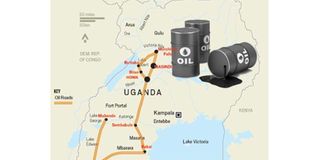Uganda runs to China for Shs2 trillion oil roads

What you need to know:
- Last December, Mr Kasaija, tabled a motion requesting Parliament to allow withdraw of Shs116.6b from the Fund as a supplementary budget to Unra but the request was blocked.
- The oil companies, according to estimates by ministry of Energy, are expected to invest up to $8b (Shs23t) in the next phase of development leading first oil.
Kampala. The government has turned to China’s Export–Import (EXIM) Bank to secure funding for the construction of ten “critical oil roads” in the oil belt, Albertine Graben, in South Western Uganda needed urgently to ease the ongoing process of expediting commercial oil production to start by 2020.
Daily Monitor understands that ministry of Finance has already put in a loan request for more than $500m (Shs1.8t) which will be supplemented by withdrawals from the Petroleum Fund and additional funding from the ongoing budgetary cuts.
Finance minister Matia Kasaija, who was early this week due to travel Beijing with a delegation from government to further discussions with EXIM Bank on funding for the multi-billion Standard Gauge Railway (SGR) but the arrangement has since suffered some setbacks, confirmed the loan request and said they need $564m (approx. Shs2t) for the oil roads.
“It is true we put in the request and discussions are ongoing; to see how they can help us,” Mr Kasaija told this newspaper. “It is a matter of prioritising, and we have made it clear that these roads are much needed to help us get oil out of the ground.”
The ministry of Finance is already enforcing a 10 percent budget cut for all ministries and agencies on the directive of President Museveni with hopes of raising money for the ten road projects in the Albertine Graben.
According to the Uganda National Roads Authority (Unra) the roads are, Hoima-Butiaba-Wanseko road (111km), Masindi-Biiso (54km), Masindi-Bugungu via Murchison Falls National Park (80km), Kaseeta - Lwera via Bugoma Forest (16km), Hohwa-Nyairongo-Kyarushesha road (25km), and Wanseko-Bugungu (23km).
Others include Lusalira- Nkonge-Sembabule (97km), Kyotera – Rakai (20km), Buhimba-Nalweyo-Kakindu-Kakumiro-Mubende (100km) and Kabale – Kiziramfumbi road (30km). Unra executive director Allen Kagina told this newspaper yesterday that feasibility studies for the selected roads is ongoing to establish their actual costs.
“We are working very hard and each day counts; we plan to be through with every process including awarding contracts by June because the roads have to be ready by 2019,” Ms Kagina said.
Besides the $564m government needs between Shs117b-Shs212b ($50m-$60m)for land acquisition and compensation of property along the proposed right of way.
Mr Kasaija said the government already is sure to raise $33m (approx Shs116b) from the Petroleum Fund subject to approval from Parliament. The Fund managed by Bank of Uganda is established by the Public Finance Management Act 2015 to receive all petroleum revenues upon collection by the Uganda Revenue Authority.
The Fund has two objectives, financing the budget and saving/investment for the future generations; therefore withdrawals from the Fund are only allowed to go to the Consolidated Fund for the first purpose.
According to the Bank of Uganda 2015/16 Annual Report, the Fund contained Shs245.b as at the end of last financial year following an additional payment made by Tullow of the balance from the out of court settlement with URA over Capital Gains Taxes.
Last December, Mr Kasaija, tabled a motion requesting Parliament to allow withdraw of Shs116.6b from the Fund as a supplementary budget to Unra but the request was blocked. Parliament said the government had not followed the necessary laws to move the money.
With aid taps lately turning very slowly the government is badly in need of oil revenues and on which they are borrowing heavily as a guarantee. The International oil companies, Tullow, France’s Total and China’s Cnooc, have been mounting enormous pressure on government accelerate the processes and have the infrastructures required in place by 2020 to facilitate oil production to start.
The oil companies, according to estimates by ministry of Energy, are expected to invest up to $8b (Shs23t) in the next phase of development leading first oil. This is on top of other required infrastructures like the $3.5b (Shs11t) 1,445km crude export pipeline to Tanzania and the $4b (Shs13t) Greenfield refinery.



